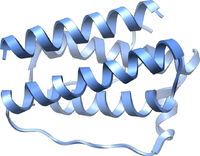
Photo from wikipedia
Introduction Adipokines are signaling molecules involved in the integration of metabolism. Changes in their concentrations were observed in obesity, metabolic syndrome, diabetes mellitus and cardiovascular diseases, as well as endocrine… Click to show full abstract
Introduction Adipokines are signaling molecules involved in the integration of metabolism. Changes in their concentrations were observed in obesity, metabolic syndrome, diabetes mellitus and cardiovascular diseases, as well as endocrine disorders. Cushing’s syndrome is associated with metabolic dysregulation, but the significance of adipokines in this entity and related complications is largely unknown. The aim of our study was to determine the concentrations of adipokines: fetuin A, fatty acid binding protein 4 (FABP4) and retinol binding protein 4 (RBP4) in Cushing’s syndrome and to assess their relation to established cardiovascular and diabetes risk markers. Methods We examined 21 subjects with Cushing’s syndrome and 24 healthy controls in a cross-sectional manner. Venous blood samples were analysed for adipokines, cortisol, adrenocorticotrophin, glucose, insulin, glycated haemoglobin (HbA1c), triglycerides, cholesterol fractions, thyrotropin and free thyroid hormones concentrations. Patients’ body mass index (BMI) was evaluated, homeostatic model assessment-insulin resistance and Systematic Coronary Risk Evaluation (SCORE) were calculated. Results We found that the concentration of fetuin A was lower, while FABP4 and RBP4 concentrations were higher in Cushing’s syndrome compared to controls [156.4 ± 60.0 µg/ml vs 260.7 ± 49.6 µg/ml; 79.8 (35.2-156.1) ng/ml vs 27.9 (17.1-36.7) ng/ml and 34 (30-37.7) mg/l vs 25.8 (23.6-27.7) mg/l, respectively]. Fetuin A correlated inversely, while FABP4 and RBP4 positively, with the concentrations of urinary free cortisol and adrenocorticotrophin. Fetuin A was positively related to LDL-cholesterol, and negatively to SCORE and HbA1c. FABP4 was associated positively with BMI, HbA1c and triglycerides, while RBP4 correlated positively with triglycerides and systolic blood pressure. Conclusions Adipokines’ concentrations change in hypercortisolism. Further research is needed to ascertain whether adipokines are involved in the development of metabolic complications accompanying Cushing’s syndrome or secondarily reflect metabolic dysregulation.
Journal Title: Frontiers in Endocrinology
Year Published: 2022
Link to full text (if available)
Share on Social Media: Sign Up to like & get
recommendations!